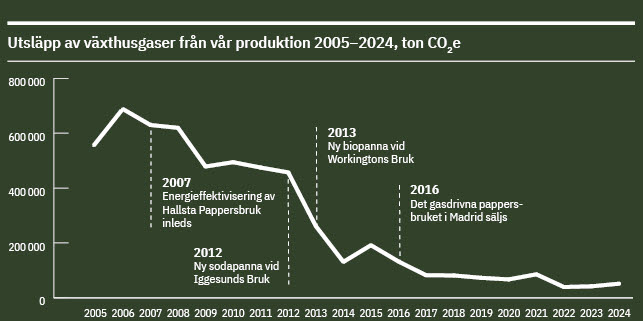- Holmen /
- Climate benefit
How we contribute to the climate
In 2024, Holmen contributed a climate benefit of 8.3 million tonnes of CO2e, which can be compared to Sweden's total emissions, which amounted to 45 million tonnes in 2023.
Our climate benefit increase with a growing business
The forest is most useful when it is used. This is the core of Holmen's business and our goal is to increase our contribution to the climate transition throughout our value chain. By reporting climate benefit, we show how Holmen's operations contribute to the reduction of carbon dioxide in the atmosphere and how we help our customers reduce the climate footprint of their business.
Growing forests bind carbon dioxide
Increased storage through growth in our forests and sales of products that store CO2.
Replacement of fossil products
Substitution when our wood and fibre products and renewable energy replace fossil alt.
Emissions in our operations
The majority of our emissions come from transport and the purchase of input products.
How we deliver climate benefit
The forest stores carbon dioxide when the trees grow
Young trees have the greatest ability to bind carbon dioxide. As trees grow old, growth slows down and when they finally die and decompose, the carbon dioxide stored returns to the atmosphere. Through active forestry, where the trees are harvested when growth slows down and the land is then reforested, we increase the forest's growth and absorption capacity over time. In 2024, the increase in standing stock in Holmen's forests is estimated to have absorbed 2.1 million tonnes of carbon dioxide, net after harvest.
Carbon dioxide is stored in long-lived products
After harvesting, the raw material from the forest continues to bind carbon dioxide even in a refined form. In long-lived products such as wood products, the carbon dioxide is stored for a long time when they become homes and homes, while the storage in short-lived products made of cardboard and paper takes place for a shorter time. In 2024, sales of our products contributed to increased carbon dioxide storage of 0.4 million tonnes.
Replacement of fossil-based products
With a renewable raw material and resource-efficient production, we can offer our customers products with a low climate footprint that allows the world to avoid fossil emissions. Wood products can be used instead of cement and steel to reduce the real estate sector's carbon dioxide emissions. By replacing fossil-based materials such as plastic with bio-based alternatives, the climate footprint is reduced. In 2024, our wood and fibre products replaced fossil materials equivalent to 4.4 million tonnes of carbon dioxide equivalents.
Substitution with renewable energy production
With its own production of renewable energy in the form of hydropower, wind power and biomass, Holmen takes responsibility for our own electricity consumption while contributing to Europe's green transition. In 2024, our production of hydropower, wind power and biomass helped to avoid 2.1 million tonnes of carbon dioxide equivalents.
How we have calculated
In 2024, Holmen updated the calculation method for climate benefits in accordance with the Climate Effect Assessment and Reporting (CLEAR) model. By using the CLEAR model for calculating climate benefits , we can report our climate impact and the positive effects our operations have on the climate in a transparent and standardized way.
Since 2024, Skogforsk has been managing and further developing the calculation model. This allows for harmonisation with national reporting. The model is continuously updated based on new research and is on its way to becoming an ISO standard.
Emission reduction targets
As early as 2005, Holmen set the goal of reducing the use of fossil fuels by 90 per cent by 2020. Today, scope 1 emissions follow the required rate of reduction for the Paris Agreement's 1.5-degree target.

As part of Holmen's climate targets, Group Management decided in 2021 to reduce greenhouse gas emissions by 2030:
- 15 percent reduction in emissions from operations (scope 1 and 2).
- 22 percent reduction in emissions from transport (scope 3).
- 22 percent reduction in emissions from forest machines (scope 3).
- 35 percent of emissions from purchased goods and services must be covered by science-based climate targets by 2025.
Holmen's emission targets have also been certified by the UN-affiliated Science Based Targets initiative (SBTi).
Contact sustainability issues

Stina Sandell
Senior vice President Sustainability and Communications



